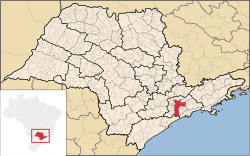São Paulo
From Wikipedia, the free encyclopedia
This article is about the city. For the state, see São Paulo (state). For other uses, see São Paulo (disambiguation).
| São Paulo | |||
|---|---|---|---|
| — Municipality — | |||
| The Municipality of São Paulo | |||
| Images, from top, left to right: Octavio Frias de Oliveira bridge, São Paulo Skyline, Ibirapuera Park, São Paulo Museum of Art; São Paulo Cathedral; Brooklin district with office buildings alongside the Pinheiros River. | |||
| |||
| Nickname(s): Terra da Garoa (Land of Drizzle) and Sampa | |||
| Motto: "Non ducor, duco" (Latin) "I am not led, I lead" | |||
| | |||
| Coordinates: 23°33′01″S 46°38′02″W / 23.55028°S 46.63389°WCoordinates: 23°33′01″S 46°38′02″W / 23.55028°S 46.63389°W | |||
| Country | |||
| Region | Southeast | ||
| State | |||
| Founded | January 25, 1554 | ||
| Government | |||
| - Mayor | Gilberto Kassab (Democrats) | ||
| Area | |||
| - Municipality | 1,522.986 km2 (588 sq mi) | ||
| - Metro | 7,943.818 km2 (3,067.1 sq mi) | ||
| Elevation | 760 m (2,493.4 ft) | ||
| Population (2009) | |||
| - Municipality | 11.037.593 (1st) | ||
| - Density | 7,216.3/km2 (18,690.1/sq mi) | ||
| - Metro | 19.889.559 | ||
| - Metro Density | 2,469.35/km2 (6,395.6/sq mi) | ||
| Time zone | UTC-3 (UTC-3) | ||
| - Summer (DST) | UTC-2 (UTC-2) | ||
| Postal Code | 01000-000 | ||
| HDI (2000) | 0.841–high[1] | ||
| Website | City of São Paulo | ||
The city has many renowned landmarks, such as the Museu Paulista do Ipiranga, the gothic Metropolitan Sé Cathedral, the Museu de Arte de São Paulo MASP, the Bandeirantes monument and Niemeyer's Ibirapuera complex Bienal, planetarium, and museums; and more recently the Estaiada bridge in the South Side. Paulista Avenue, in Midtown is the most important financial center in the country and South America.
The city is home to the São Paulo Stock Exchange, or BOVESPA, the Future Markets, and the Cereal Market Stock Exchanges. São Paulo has been home to several of the tallest buildings in Brazil, including the Mirante do Vale Building.[4]
With an estimated population of 11,037,593 residents[5] within an area of 1,523 square kilometers (588.0 sq mi),[6] São Paulo is the most populous city in the Southern hemisphere.[7]
The city also lies at the center of the heavily urbanized São Paulo metropolitan area, with an estimated 19,889,559 people in 2009[8] over 7,944 square kilometers (3,067.2 sq mi),[9] is the largest metropolitan area in the nation. Depending on which definition is used, the São Paulo metropolitan area is ranked as either the first or second most populous in the Americas.[10]
People from the city of São Paulo are known as paulistanos, while paulistas designates anyone from the whole of São Paulo state, including the paulistanos. The city's Latin motto, which it has shared with the battleship and the aircraft carrier named after it, is Non ducor, duco, which translates as "I am not led, I lead".[11]
A famous nickname for the city is "Sampa". São Paulo is also known for its unreliable weather, the size of its helicopter fleet, architecture, gastronomy, and multitude of skyscrapers.[12] The São Paulo/Guarulhos International Airport operates many domestic and international flights.











No comments:
Post a Comment